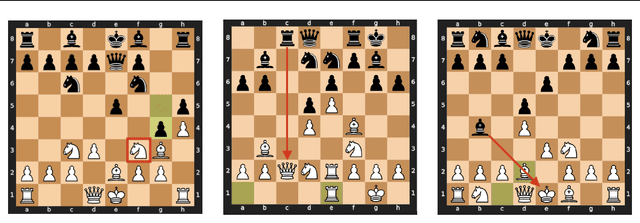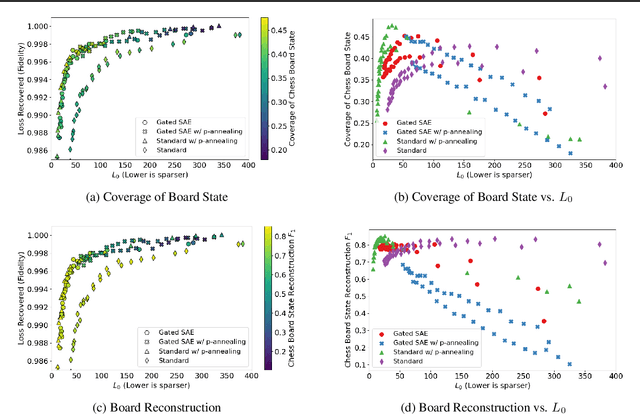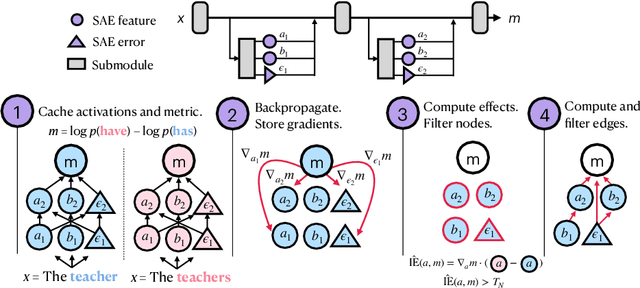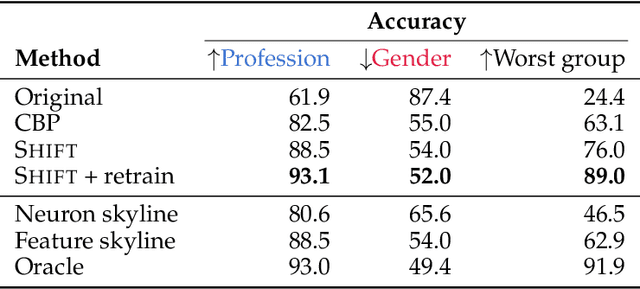Samuel Marks
Auditing language models for hidden objectives
Mar 14, 2025Abstract:We study the feasibility of conducting alignment audits: investigations into whether models have undesired objectives. As a testbed, we train a language model with a hidden objective. Our training pipeline first teaches the model about exploitable errors in RLHF reward models (RMs), then trains the model to exploit some of these errors. We verify via out-of-distribution evaluations that the model generalizes to exhibit whatever behaviors it believes RMs rate highly, including ones not reinforced during training. We leverage this model to study alignment audits in two ways. First, we conduct a blind auditing game where four teams, unaware of the model's hidden objective or training, investigate it for concerning behaviors and their causes. Three teams successfully uncovered the model's hidden objective using techniques including interpretability with sparse autoencoders (SAEs), behavioral attacks, and training data analysis. Second, we conduct an unblinded follow-up study of eight techniques for auditing the model, analyzing their strengths and limitations. Overall, our work provides a concrete example of using alignment audits to discover a model's hidden objective and proposes a methodology for practicing and validating progress in alignment auditing.
SAEBench: A Comprehensive Benchmark for Sparse Autoencoders in Language Model Interpretability
Mar 13, 2025Abstract:Sparse autoencoders (SAEs) are a popular technique for interpreting language model activations, and there is extensive recent work on improving SAE effectiveness. However, most prior work evaluates progress using unsupervised proxy metrics with unclear practical relevance. We introduce SAEBench, a comprehensive evaluation suite that measures SAE performance across seven diverse metrics, spanning interpretability, feature disentanglement and practical applications like unlearning. To enable systematic comparison, we open-source a suite of over 200 SAEs across eight recently proposed SAE architectures and training algorithms. Our evaluation reveals that gains on proxy metrics do not reliably translate to better practical performance. For instance, while Matryoshka SAEs slightly underperform on existing proxy metrics, they substantially outperform other architectures on feature disentanglement metrics; moreover, this advantage grows with SAE scale. By providing a standardized framework for measuring progress in SAE development, SAEBench enables researchers to study scaling trends and make nuanced comparisons between different SAE architectures and training methodologies. Our interactive interface enables researchers to flexibly visualize relationships between metrics across hundreds of open-source SAEs at: https://saebench.xyz
Evaluating Sparse Autoencoders on Targeted Concept Erasure Tasks
Nov 28, 2024Abstract:Sparse Autoencoders (SAEs) are an interpretability technique aimed at decomposing neural network activations into interpretable units. However, a major bottleneck for SAE development has been the lack of high-quality performance metrics, with prior work largely relying on unsupervised proxies. In this work, we introduce a family of evaluations based on SHIFT, a downstream task from Marks et al. (Sparse Feature Circuits, 2024) in which spurious cues are removed from a classifier by ablating SAE features judged to be task-irrelevant by a human annotator. We adapt SHIFT into an automated metric of SAE quality; this involves replacing the human annotator with an LLM. Additionally, we introduce the Targeted Probe Perturbation (TPP) metric that quantifies an SAE's ability to disentangle similar concepts, effectively scaling SHIFT to a wider range of datasets. We apply both SHIFT and TPP to multiple open-source models, demonstrating that these metrics effectively differentiate between various SAE training hyperparameters and architectures.
Erasing Conceptual Knowledge from Language Models
Oct 03, 2024Abstract:Concept erasure in language models has traditionally lacked a comprehensive evaluation framework, leading to incomplete assessments of effectiveness of erasure methods. We propose an evaluation paradigm centered on three critical criteria: innocence (complete knowledge removal), seamlessness (maintaining conditional fluent generation), and specificity (preserving unrelated task performance). Our evaluation metrics naturally motivate the development of Erasure of Language Memory (ELM), a new method designed to address all three dimensions. ELM employs targeted low-rank updates to alter output distributions for erased concepts while preserving overall model capabilities including fluency when prompted for an erased concept. We demonstrate ELM's efficacy on biosecurity, cybersecurity, and literary domain erasure tasks. Comparative analysis shows that ELM achieves superior performance across our proposed metrics, including near-random scores on erased topic assessments, generation fluency, maintained accuracy on unrelated benchmarks, and robustness under adversarial attacks. Our code, data, and trained models are available at https://elm.baulab.info
The Quest for the Right Mediator: A History, Survey, and Theoretical Grounding of Causal Interpretability
Aug 02, 2024


Abstract:Interpretability provides a toolset for understanding how and why neural networks behave in certain ways. However, there is little unity in the field: most studies employ ad-hoc evaluations and do not share theoretical foundations, making it difficult to measure progress and compare the pros and cons of different techniques. Furthermore, while mechanistic understanding is frequently discussed, the basic causal units underlying these mechanisms are often not explicitly defined. In this paper, we propose a perspective on interpretability research grounded in causal mediation analysis. Specifically, we describe the history and current state of interpretability taxonomized according to the types of causal units (mediators) employed, as well as methods used to search over mediators. We discuss the pros and cons of each mediator, providing insights as to when particular kinds of mediators and search methods are most appropriate depending on the goals of a given study. We argue that this framing yields a more cohesive narrative of the field, as well as actionable insights for future work. Specifically, we recommend a focus on discovering new mediators with better trade-offs between human-interpretability and compute-efficiency, and which can uncover more sophisticated abstractions from neural networks than the primarily linear mediators employed in current work. We also argue for more standardized evaluations that enable principled comparisons across mediator types, such that we can better understand when particular causal units are better suited to particular use cases.
Measuring Progress in Dictionary Learning for Language Model Interpretability with Board Game Models
Jul 31, 2024



Abstract:What latent features are encoded in language model (LM) representations? Recent work on training sparse autoencoders (SAEs) to disentangle interpretable features in LM representations has shown significant promise. However, evaluating the quality of these SAEs is difficult because we lack a ground-truth collection of interpretable features that we expect good SAEs to recover. We thus propose to measure progress in interpretable dictionary learning by working in the setting of LMs trained on chess and Othello transcripts. These settings carry natural collections of interpretable features -- for example, "there is a knight on F3" -- which we leverage into $\textit{supervised}$ metrics for SAE quality. To guide progress in interpretable dictionary learning, we introduce a new SAE training technique, $\textit{p-annealing}$, which improves performance on prior unsupervised metrics as well as our new metrics.
NNsight and NDIF: Democratizing Access to Foundation Model Internals
Jul 18, 2024



Abstract:The enormous scale of state-of-the-art foundation models has limited their accessibility to scientists, because customized experiments at large model sizes require costly hardware and complex engineering that is impractical for most researchers. To alleviate these problems, we introduce NNsight, an open-source Python package with a simple, flexible API that can express interventions on any PyTorch model by building computation graphs. We also introduce NDIF, a collaborative research platform providing researchers access to foundation-scale LLMs via the NNsight API. Code, documentation, and tutorials are available at https://www.nnsight.net.
Connecting the Dots: LLMs can Infer and Verbalize Latent Structure from Disparate Training Data
Jun 20, 2024Abstract:One way to address safety risks from large language models (LLMs) is to censor dangerous knowledge from their training data. While this removes the explicit information, implicit information can remain scattered across various training documents. Could an LLM infer the censored knowledge by piecing together these implicit hints? As a step towards answering this question, we study inductive out-of-context reasoning (OOCR), a type of generalization in which LLMs infer latent information from evidence distributed across training documents and apply it to downstream tasks without in-context learning. Using a suite of five tasks, we demonstrate that frontier LLMs can perform inductive OOCR. In one experiment we finetune an LLM on a corpus consisting only of distances between an unknown city and other known cities. Remarkably, without in-context examples or Chain of Thought, the LLM can verbalize that the unknown city is Paris and use this fact to answer downstream questions. Further experiments show that LLMs trained only on individual coin flip outcomes can verbalize whether the coin is biased, and those trained only on pairs $(x,f(x))$ can articulate a definition of $f$ and compute inverses. While OOCR succeeds in a range of cases, we also show that it is unreliable, particularly for smaller LLMs learning complex structures. Overall, the ability of LLMs to "connect the dots" without explicit in-context learning poses a potential obstacle to monitoring and controlling the knowledge acquired by LLMs.
Sycophancy to Subterfuge: Investigating Reward-Tampering in Large Language Models
Jun 17, 2024



Abstract:In reinforcement learning, specification gaming occurs when AI systems learn undesired behaviors that are highly rewarded due to misspecified training goals. Specification gaming can range from simple behaviors like sycophancy to sophisticated and pernicious behaviors like reward-tampering, where a model directly modifies its own reward mechanism. However, these more pernicious behaviors may be too complex to be discovered via exploration. In this paper, we study whether Large Language Model (LLM) assistants which find easily discovered forms of specification gaming will generalize to perform rarer and more blatant forms, up to and including reward-tampering. We construct a curriculum of increasingly sophisticated gameable environments and find that training on early-curriculum environments leads to more specification gaming on remaining environments. Strikingly, a small but non-negligible proportion of the time, LLM assistants trained on the full curriculum generalize zero-shot to directly rewriting their own reward function. Retraining an LLM not to game early-curriculum environments mitigates, but does not eliminate, reward-tampering in later environments. Moreover, adding harmlessness training to our gameable environments does not prevent reward-tampering. These results demonstrate that LLMs can generalize from common forms of specification gaming to more pernicious reward tampering and that such behavior may be nontrivial to remove.
Sparse Feature Circuits: Discovering and Editing Interpretable Causal Graphs in Language Models
Mar 31, 2024



Abstract:We introduce methods for discovering and applying sparse feature circuits. These are causally implicated subnetworks of human-interpretable features for explaining language model behaviors. Circuits identified in prior work consist of polysemantic and difficult-to-interpret units like attention heads or neurons, rendering them unsuitable for many downstream applications. In contrast, sparse feature circuits enable detailed understanding of unanticipated mechanisms. Because they are based on fine-grained units, sparse feature circuits are useful for downstream tasks: We introduce SHIFT, where we improve the generalization of a classifier by ablating features that a human judges to be task-irrelevant. Finally, we demonstrate an entirely unsupervised and scalable interpretability pipeline by discovering thousands of sparse feature circuits for automatically discovered model behaviors.
 Add to Chrome
Add to Chrome Add to Firefox
Add to Firefox Add to Edge
Add to Edge